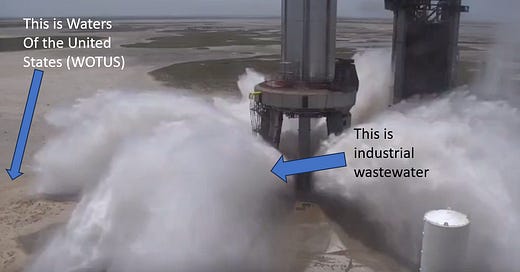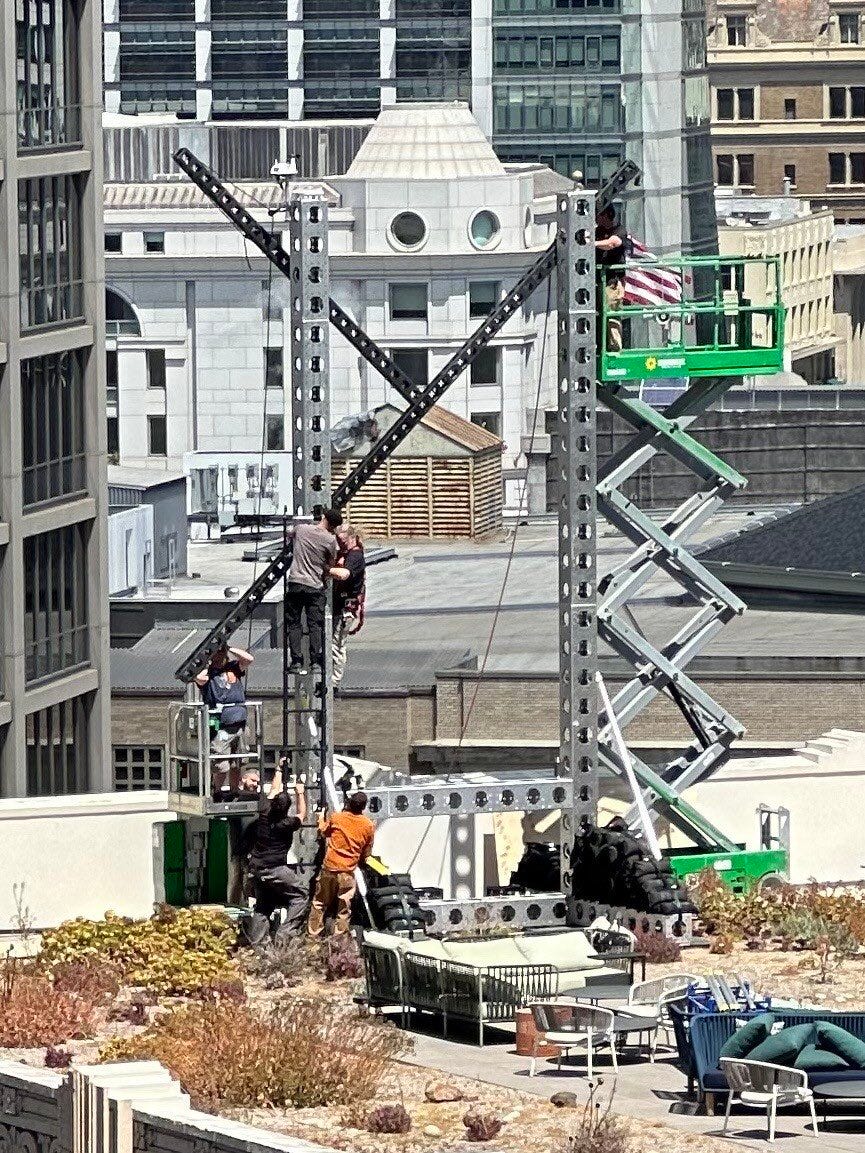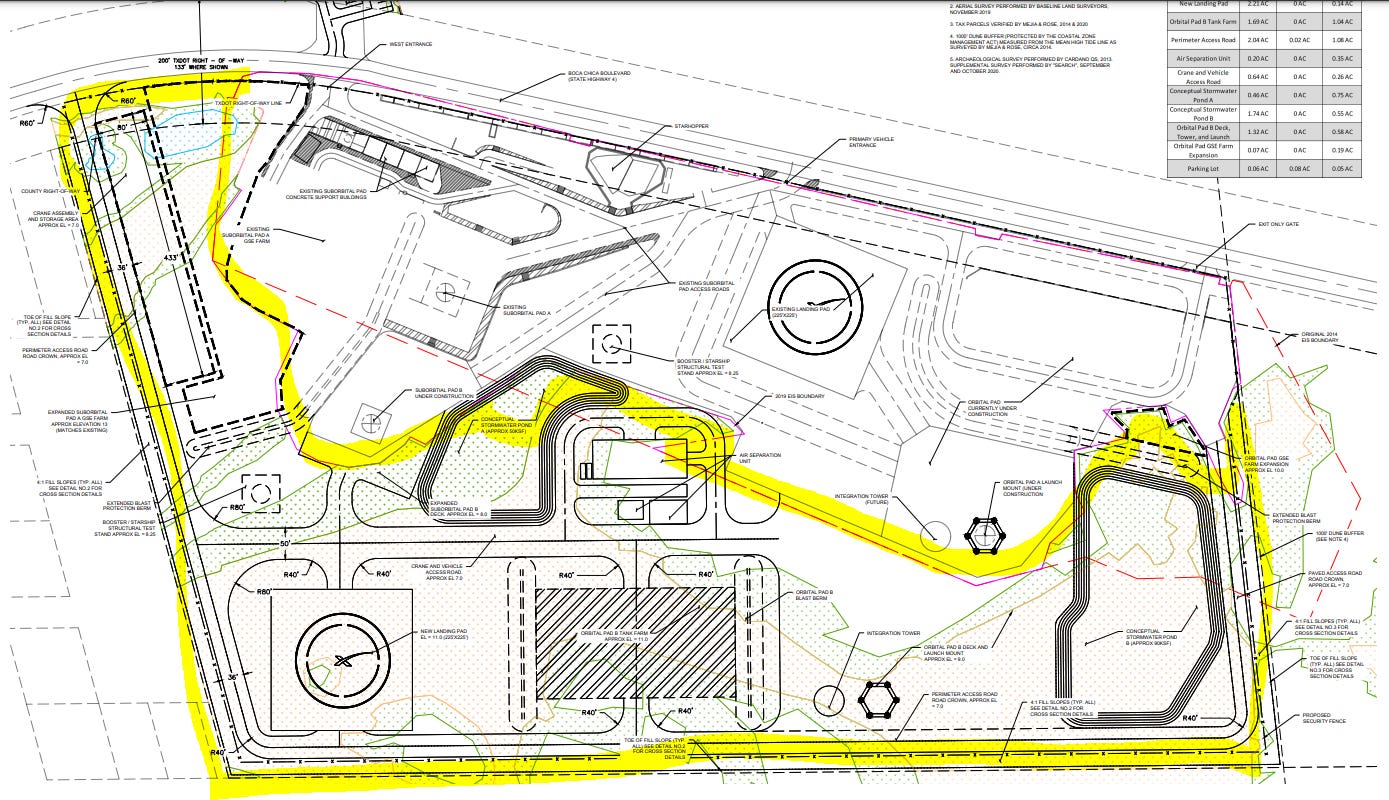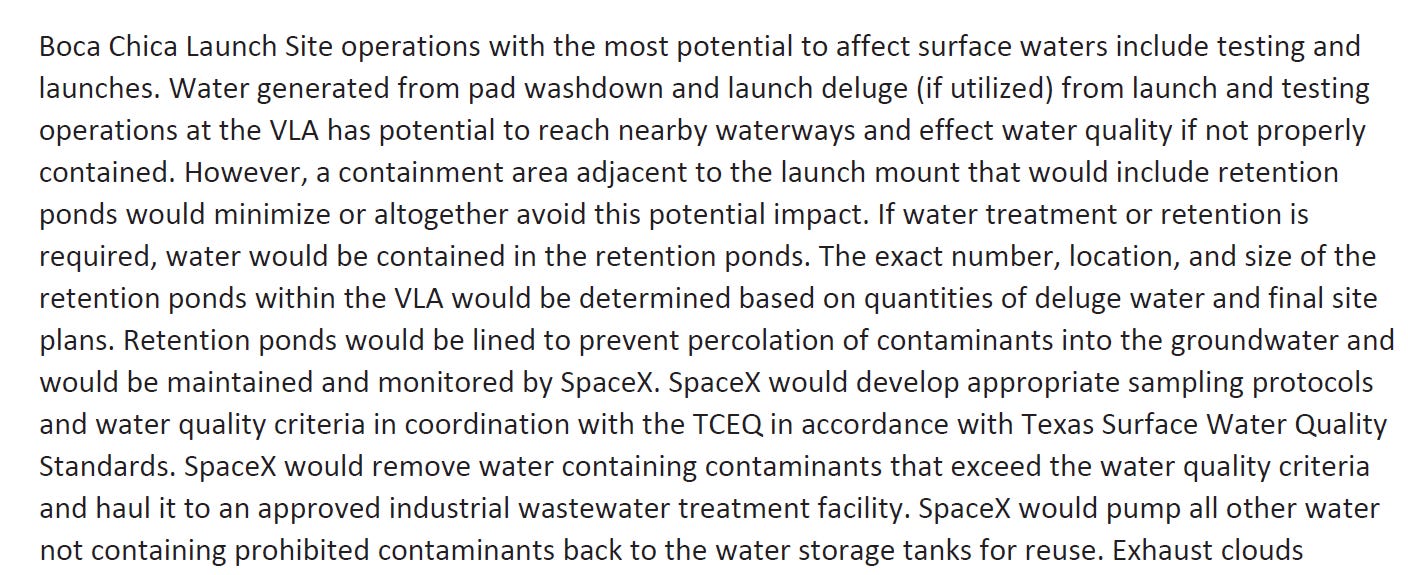For the past few weeks, I’ve been mulling over the right contextual hook to describe why it matters that Elon Musk, the world’s most visibly divorced man, simply cannot be bothered to comply with the law. And then, as luck would have it, this week the heavens opened up and dropped a giant steel “X” sign on the roof of Twitter/X Corp’s San Francisco headquarters. Search promptly over.
Musk’s ham-fisted rebrand of Twitter into X has been understandably seized upon by the internet commentariat and press as just another example of his rapidly decaying PR prowess. Last Monday, a work crew arrived at Twitter/X HQ and started dismantling the existing Twitter sign.
The X Corp did not get any prior authorization for either the work activity or the sign change itself. Because… of course they didn’t. Unsurprisingly, SF Police shut down the activity promptly.
People on the internet who defend Musk like it’s their full-time job quickly jumped on this as red tape overkill and yet another sign of tyranny from a big “woke” city. This is certainly less crazy than other recent Musk decisions, but it’s still wild, looking at the videos, that the work crew seemingly didn’t even bother to properly tape off the area to prevent injury to any passers-by. And while I don’t want to act like this is a world-ending risk, the fact that a Musk company once again decided to do something without a permit is simply too juicy for me to ignore.
A few days later, the company erected, once again without any sort of approval, a massive, ugly “X” on the rooftop, constructed out of structural steel and crudely installed with no consideration for public safety or engineering and architectural standards.
Obvious and numerous OSHA violations aside, the above image displays an astoundingly farcical construction and engineering undertaking.
You may have heard that San Francisco sits right on top of the San Andreas fault line, is sandwiched between two others (Hayward and San Gergorio), and has something of a reputation as being prone to regular shaking and rumbling from the underlying seismic activity. A forty-foot tall structure, constructed of steel, weighing thousands of pounds, with dimensions that are far taller than wide, being hastily erected on top of a building, with strapped-on sandbags as the primary counterweight does not exactly inspire confidence on the public safety front.
If that wasn't enough, later that evening, the company turned on the lights affixed to the X.

It's as if Musk wanted to give a real-time demonstration of why permitting exists. I doubt even the staunchest libertarian tech bro in the Bay Area would be pleased if their neighbor just decided one day to start blasting a white-hot, strobing spotlight into their apartment every single night.
Even the least-woke city in America has a municipal code that regulates such things as “putting a massive steel structure on top of a building” and “blinding every person within 3 square blocks.” For example, Midland, Texas’ municipal and building codes prohibit what X Corp did (I checked!).
The horrible beauty of this entire affair is that this is a concrete example of the kind of soft-NIMBYism that 99% of the population can comprehend and get behind. “We live in a society” kinda stuff.
Consequences Be Damned
The really interesting piece here is looking at how this behavior can happen. Provided that the Giant X does not fall and crush pedestrians to death (not a great bet), then all of this sign bruhaha is purely a civil matter. Musk will stonewall, block inspections, ignore court orders, and mock the entire process. He’s already started doing these things. He may finally relent in the coming days or weeks, and the sign will come down. Penalties will never exceed any amount that Musk cannot pay with a triflingly small check given his net worth. He may take a few dings to his already shredded reputation, but ultimately there is no consequence in our legal system to deter this behavior from the immature and unserious billionaire.
Musk would be far from the first obscenely rich American to thumb his nose at the very concept of regulation. But in the past few decades, this kind of stubbornly petty regulatory subversion has petered out, especially among manufacturers and hard industrial companies. It’s not that the executives of hard industry are good. Rather, they generally play by the rules on the surface and subvert the law by lobbying Congress for carveouts and loopholes. They also distance themselves from actions individual managers and employees may take that break the law. The “I didn’t know my unrelenting pressure to make the numbers no matter what would lead individual employees to break the rules!” school of thought, if you will.
CLICK THE LITTLE 💓AT THE BOTTOM IF YOU ENJOY THIS! AND PLEASE SUBSCRIBE
SpaceX’s Permitting Woes
This post was intended to be focused on SpaceX’s current issues, and as desperately as I would like to stop writing about the company’s ongoing comedy of errors in South Texas, it’s impossible to look away. So the extended introduction involving a big silly sign may seem like a non-sequitur, but I think it’s a fascinating parallel with the latest developments at Starbase.
Back in April, I laid out the case that the Boca Chica launch site was woefully designed for purpose, lacking standard measures used for energy suppression (namely a flame trench and water deluge system). Unsurprisingly, the launch was a disaster for the site, with the flat, bare concrete taking the brunt of the force and sending rocks, debris and dust flying for miles away. Concrete blocks littered the sensitive wetlands that are nesting grounds for several endangered species and the nearby city of Port Isabel was showered in a thin layer of dust and launch debris.
SpaceX fans, the most normal and well-adjusted folks on the internet, assured me before the 4/20 launch that protections such as a flame trench or deluge system were frivolous and that my post was ridiculous fear-mongering. Surely the crack engineering team at SpaceX wisely skipped over these decades-old control requirements for a good reason. They were simply not needed. Duh. We know that to not be true now (take a look at that crater!). Casual observers of the company chalked it up to rote incompetence. But that’s not why SpaceX skipped these civil engineering projects. Rather they didn’t do so because:
The tiny launch pad simply doesn’t have room for such infrastructure as currently designed.
The company could not dig trenches or water containment ponds in the surrounding land they owned because most of it is protected wetlands and requires a lengthy Army Corps of Engineering Permit to begin excavation and regrading.
The company did not have to means to capture industrial wastewater from a deluge system. This water, once used for cooling purposes, requires treatment prior to being discharged into the surrounding wetlands and estuaries.
But the big crater from launch #1 posed a problem. There was no way they could try a launch like that again. Musk immediately started tweeting the idea of using a water-cooled plate for plume suppression. It was a deluge system but instead of flowing from the edges down into a pit, water would shoot out from the bottom.
A few weeks ago the company began installing this equipment, and after an initial low-pressure test, on Friday, the company gave it a go at full pressure:
There’s just one little problem here.
According to 33 U.S.C. 1319(c)(1) & (2) it is a crime for someone who “Discharges a pollutant from a point source into a water of the United States without a NPDES or 404 Permit or in violation of a permit.” Not a civil penalty, a *crime* crime, with prison sentences of up to 3 years for knowingly committing such a violation.
Without the presence of a heat source, it is perhaps a bit of a grey area if this week’s test water meets the criteria for a pollutant, but it certainly might be, given the potential washout/erosion and the fact that potable water with its chlorine and other dissolved salts may be incompatible with the background quality standards of tidal wetlands1. But let’s take a step back and look at the citation itself. A crime has occurred if someone:
“Discharges”
This is a release of water
“A pollutant”
Per the clean water act a pollutant is: dredged spoil, solid waste, incinerator residue, sewage, garbage, sewage sludge, munitions, chemical wastes, biological materials, radioactive materials, heat, wrecked or discarded equipment, rock, sand, cellar dirt and industrial, municipal, and agricultural waste discharged into water
“From a point source”
Again, per the act, a point source is: any discernible, confined and discrete conveyance, including but not limited to any pipe, ditch, channel, tunnel, conduit, well, discrete fissure, container, rolling stock, concentrated animal feeding operation, or vessel or other floating craft, from which pollutants are or may be discharged
“into a water of the United States”
“A Water of the United States” has a legal definition and one that has been endlessly litigated by the EPA and courts, but currently know that tidal wetlands are considered WOTUS2 and SpaceX’s own assessments shows that the surrounding flats are definitional regulated wetlands
“without a NPDES or 404 Permit”
Surface water discharges from industrial sites are regulated under the National Pollution Discharge Elimination System (NPDES) program. In Texas, where the TCEQ has delegated authority under the Clean Water Act, these permits are called TPDES permits.
Putting that all together, the addition of heat, products of combustion and agitated dusts and debris that will occur when SpaceX applies their deluge system (a point source) to a lit, white hot rocket engine and plume makes the water a pollutant, categorically.
The State of Texas Water Quality Standard considers any discharge into “tidal river reaches, bay, and gulf waters” that is 1.5 Degrees F (in Summer) or 4 degrees F (in Spring, Fall and Winter) above or below baseline temperatures to be a pollutant. Heat is a pollutant, it says so right in the definitions of the Clean Water Act.
So, should SpaceX fire up a some Raptor engines and use the deluge system to dampen the intense heat and energy, any water that isn’t vaporized (much, but not all of it will) that runs over the silt fenceline adjacent to the launch pad will be an illegal discharge. SpaceX needs an individual TPDES permit that mandates collection, treatment, and eventual discharge.
The problem here is that SpaceX doesn’t have such a permit. They have had years to apply for one, but simply… haven't. CNBC reported on this on Friday, the same day as the initial high-pressure water test.
In an email to CNBC, a spokesperson for the Texas Commission on Environmental Quality (TCEQ), the state’s environmental regulator, confirmed that as of July 28, SpaceX had not applied for what is called a Texas Pollutant Discharge Elimination System (TPDES) permit at its Starbase facility. The regulator said the SpaceX site has previously attained three stormwater permit authorizations.
An earlier email from TCEQ in April, prior to the initial orbital test, TCEQ’s Director of Water Quality stated the following in an email:
An individual, industrial wastewater Texas Pollutant Discharge Elimination System (TPDES) permit would be the appropriate means to authorize a discharge of deluge water.
So that begs the question:
Why Hasn’t SpaceX applied for a permit?
I suspect there are a few reasons for this. An NPDES permit is a “Pollution Discharge Elimination” authorization for a reason. SpaceX can’t just fill out some forms and get approval to do what they want. That heated water with suspended solids and trace chemicals must be collected and treated. It’s the law. Remember, water 1.5 degrees above ambient is a pollutant in the Texas Gulf. Water heated so hot that much of it vaporizes will be near boiling temperature (~212 F).
SpaceX doesn’t have the space to adequately collect this water, nor treat it in settling basins. If they wanted to dig out such ponds, they’d need an Army Corps permit that they also do not have and have not applied for. Per TCEQ, a NPDES permit takes roughly 330 days, and that's if the project isn’t complicated and doesn’t generate a lot of public comment3.
But most importantly, the second someone at SpaceX goes through the TCEQ’s forms and checklists needed to complete a permit application, they *know* that the water will be a pollutant. A mailed-in permit is an admission that you’re making industrial wastewater, and while the permit is under review, any discharges would be knowing4 violations of the Clean Water Act.
SpaceX wants to play stupid and they’re waiting until a regulator points out the obvious: rocket deluge water is an industrial waste. NASA knows this. Every deluge system at Kennedy Space Center has an NPDES industrial permit. Heck even the tiny Relativity Terran 1 launcher’s deluge system for their Methane/LOX admits this in a 2020 Environmental Assessment:
This isn’t complicated. Rocket Deluge Wastewater is an industrial waste and requires permitting that mandates collection and treatment prior to discharge. Here’s what one of NASAs wastewater systems looked like in 1998 for the Space Shuttle Launch:
Again, every freshman who has taken a wastewater treatment course understands you can’t just spray cooling water into a wetland. TCEQ knows that the heated water would be an illegal pollutant. SpaceX too is aware of this; take a look at the 2022 Environmental Assessment they wrote:
The Standoff
Circling back to the “Big X” in San Fransisco, we can see how that situation is maddening to resolve. Musk can tell his employees to do whatever he wants. The cost for non-compliance with City Muni Code will be in the (perhaps) thousands of dollars per day. That’s a reasonable cost to satisfy Mr. Musk’s ego and is decent PR for his company (NO SUCH THING AS BAD NEWS!). It’s a civil matter.
Here, we bring in criminal statute. Why hasn’t Musk just ordered his employees to dig up the surrounding wetlands and build a theme park (or a flame diverter)? I suspect it’s because no contractor in the State of Texas is gonna dig somewhere when they all know they’ll get tossed in prison for doing so without an Army Corps permit. Illegal dredging of wetlands is a big no-no. So too is illegal and unpermitted violation of the Clean Water Act. People get thrown in jail for violating this every year; see for yourself.
It’s the same thing Musk’s silly venture “The Boring Company” did in Bastrop, outside of Austin. Last year, they dug a bunch of holes in the ground, pumped out dirty water and mud, and let it run into the Colorado River. The Boring Company did this without a permit, and TCEQ slapped them on the wrist for it. There, the Boring Company used the “aw shucks, we didn’t know better” excuse.
Here, the problem is predictable. Musk and SpaceX will absolutely 100% go ahead and discharge rocket fuel-boiled water right into Waters of the United States if given the chance. Unless someone grows a pair, internally or within an agency (looking at you EPA, FAA and TCEQ) and tells SpaceX that no, they won’t illegally discharge. Unless that person likes prison.
Agencies tell this kind of stuff to companies all the time. Why no one will tell Musk “NO” continues to baffle me.
Honestly, though, this is such a cut-and-dry case of “Clean Water Act Violation waiting to happen” that it borders on absurd. I bet it gets stopped. Hopefully sooner rather than later.
We all hate permits when we face the prospect of needing them. They’re extra work and extra time. But most serious people know that permits and standards generally exist for a good reason and accept them as a part of doing business.
Musk hates permits and has the resources to just ignore them. So that’s what he does. And unless we as a society stop deciding that rules are only for little people, that the richest and most belligerent can ignore them safely, then the law is pointless. I’d hate to see it happen to the Clean Water Act. The surface water standards have protected lives and natural resources for decades. And if laws are selectively and arbitrarily enforced based on the size of a tantrum or the number of zeros in a bank account, they may as well not exist.
Until next time…
A fish or aquatic frog will die within days of living in a tank of most tap water, due to chlorine content.
Even after the recent Supreme Court Ruling which limited the extent of wetlands into the definition of WOTUS, low laying wetlands adjacent to the Gulf of Mexico are absolutely still WOTUS.
GOOD LUCK WITH THAT
33 USC specifically mandates longer penalities for Knowing violations of the CWA (3 years in prison vs one year for “negligent” violations)










